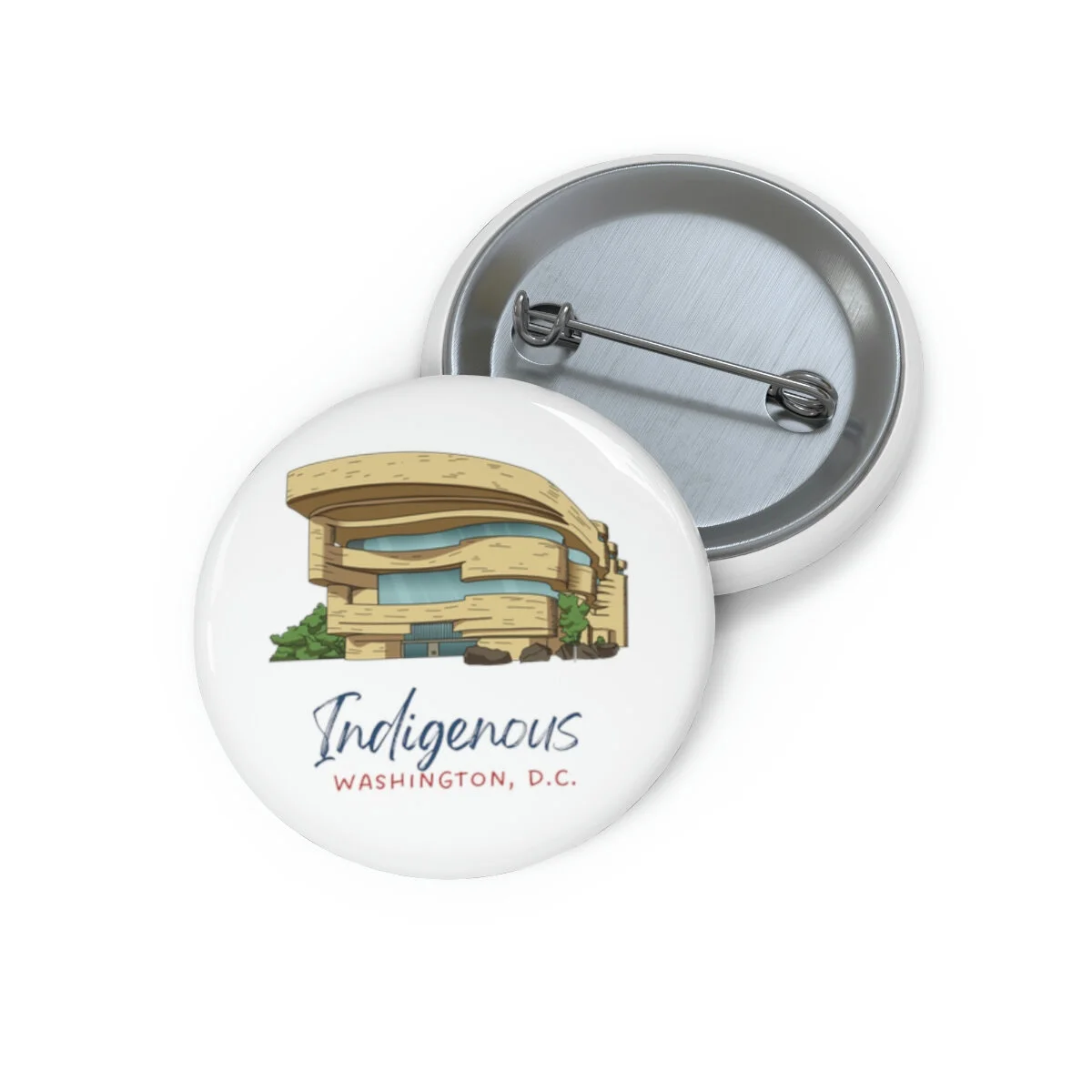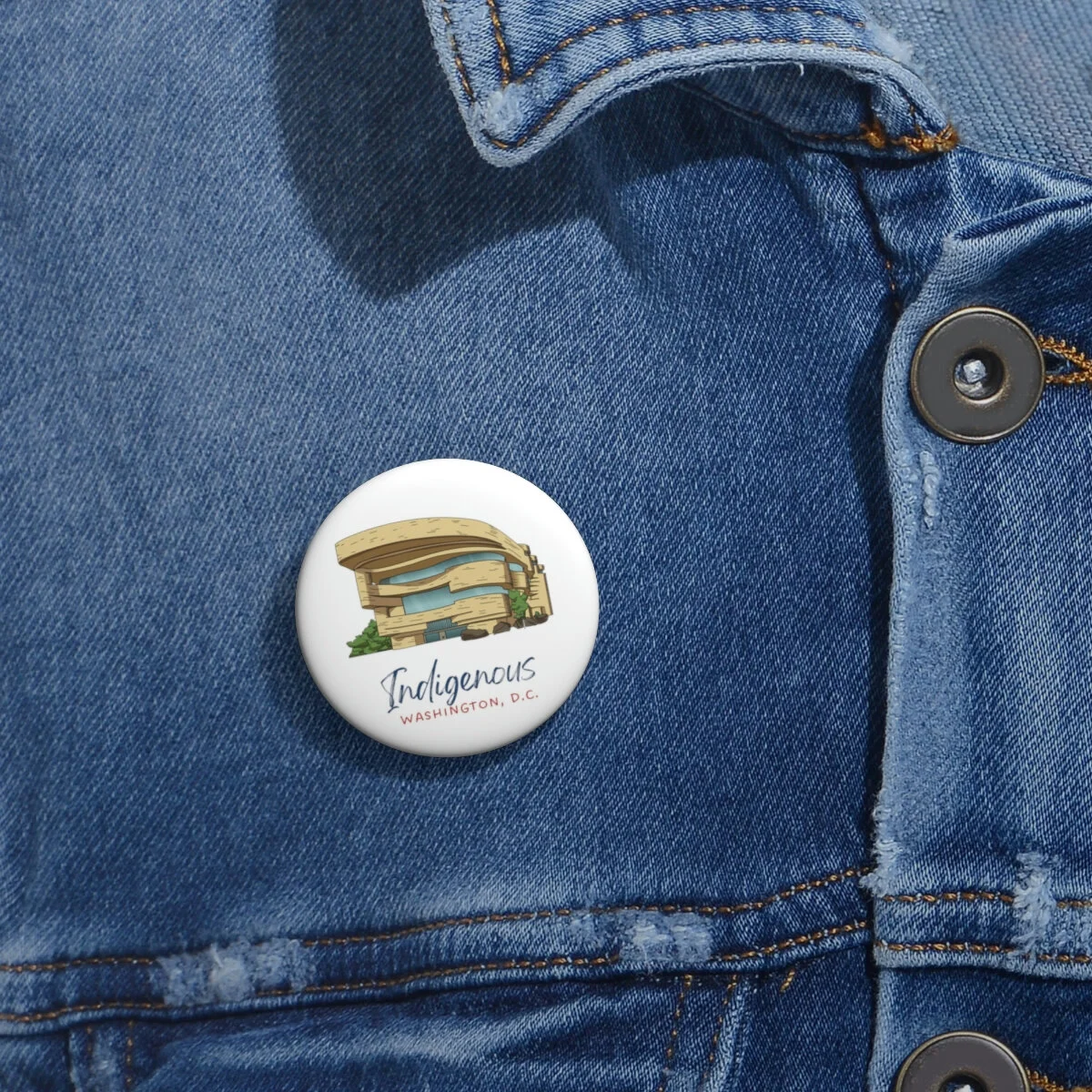Indigenous DC Pin: National Museum of the American Indian $9
Indigenous DC Pin featuring the National Museum of the American Indian map site
- Free shipping!
- 1.25" diameter
- All sales final - no returns
The Smithsonian National Museum of the American Indian is perhaps the most well-known, visible, and prominent indigenous sites in Washington, DC. The discovery of tens of thousands of indigenous objects of patrimony and human remains in the Smithsonian collections prompted Sen. Daniel Inouye to sponsor the National Museum of the American Indian Act in 1989. Fifteen years later, in 2004, the NMAI opened its doors to 250,000-square feet of exhibit space, community gathering areas, Native foods cafe, arts and crafts shop, theater, and collections. NMAI's collections and exhibitions span from the Arctic Circle to the southernmost tip of Argentina, covering the entirety of the Western Hemisphere. The architecture, landscape, and design elements were largely created to be informed by and culturally-relevant to indigenous peoples.
Of particular interest to local indigenous history, the "Return to a Native Place: Algonquian Peoples of the Chesapeake" exhibit tells the story of the Piscataway, Nanticoke, and Powhatan and their homelands in present-day Virginia, Maryland, Delaware, and Washington, DC.
In addition to its museum on the National Mall, the NMAI also includes the George Gustav Heye Center in New York City and the Cultural Resources Center in Suiteland, Maryland.
Indigenous DC Pin featuring the National Museum of the American Indian map site
- Free shipping!
- 1.25" diameter
- All sales final - no returns
The Smithsonian National Museum of the American Indian is perhaps the most well-known, visible, and prominent indigenous sites in Washington, DC. The discovery of tens of thousands of indigenous objects of patrimony and human remains in the Smithsonian collections prompted Sen. Daniel Inouye to sponsor the National Museum of the American Indian Act in 1989. Fifteen years later, in 2004, the NMAI opened its doors to 250,000-square feet of exhibit space, community gathering areas, Native foods cafe, arts and crafts shop, theater, and collections. NMAI's collections and exhibitions span from the Arctic Circle to the southernmost tip of Argentina, covering the entirety of the Western Hemisphere. The architecture, landscape, and design elements were largely created to be informed by and culturally-relevant to indigenous peoples.
Of particular interest to local indigenous history, the "Return to a Native Place: Algonquian Peoples of the Chesapeake" exhibit tells the story of the Piscataway, Nanticoke, and Powhatan and their homelands in present-day Virginia, Maryland, Delaware, and Washington, DC.
In addition to its museum on the National Mall, the NMAI also includes the George Gustav Heye Center in New York City and the Cultural Resources Center in Suiteland, Maryland.
Indigenous DC Pin featuring the National Museum of the American Indian map site
- Free shipping!
- 1.25" diameter
- All sales final - no returns
The Smithsonian National Museum of the American Indian is perhaps the most well-known, visible, and prominent indigenous sites in Washington, DC. The discovery of tens of thousands of indigenous objects of patrimony and human remains in the Smithsonian collections prompted Sen. Daniel Inouye to sponsor the National Museum of the American Indian Act in 1989. Fifteen years later, in 2004, the NMAI opened its doors to 250,000-square feet of exhibit space, community gathering areas, Native foods cafe, arts and crafts shop, theater, and collections. NMAI's collections and exhibitions span from the Arctic Circle to the southernmost tip of Argentina, covering the entirety of the Western Hemisphere. The architecture, landscape, and design elements were largely created to be informed by and culturally-relevant to indigenous peoples.
Of particular interest to local indigenous history, the "Return to a Native Place: Algonquian Peoples of the Chesapeake" exhibit tells the story of the Piscataway, Nanticoke, and Powhatan and their homelands in present-day Virginia, Maryland, Delaware, and Washington, DC.
In addition to its museum on the National Mall, the NMAI also includes the George Gustav Heye Center in New York City and the Cultural Resources Center in Suiteland, Maryland.



